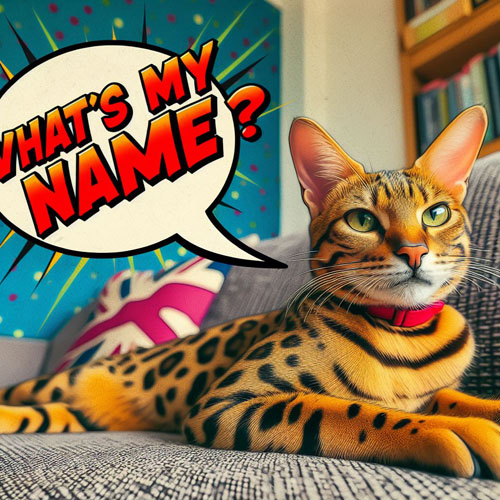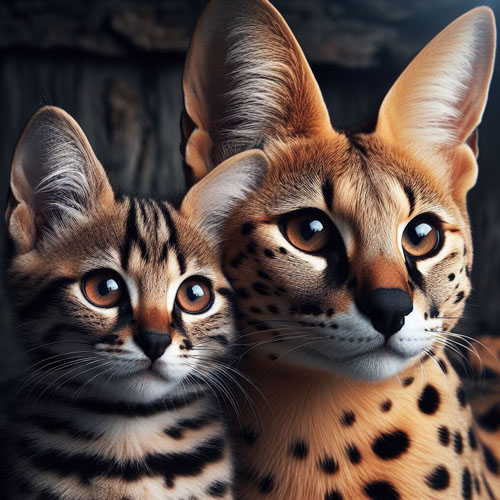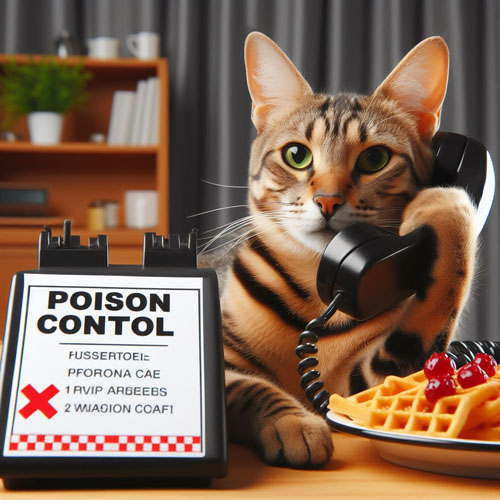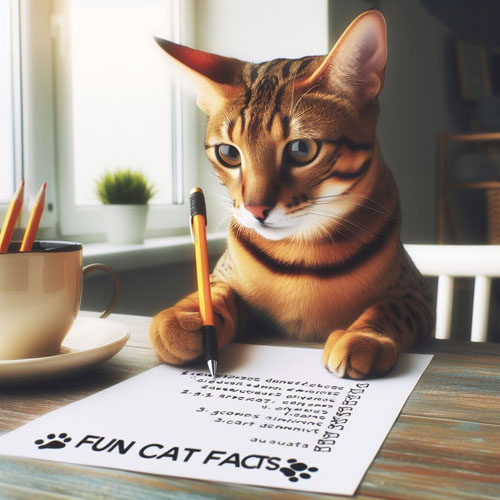The Creation Of The Savannah Cat
The African Serval and Its Pivotal Role in Developing the Savannah Cat Breed
The African Serval (Leptailurus serval) is a captivating wild cat native to the grasslands of Africa. Renowned for its distinctive appearance and remarkable hunting abilities, the Serval has played a pivotal role in the development of the Savannah cat breed. This article delves into the characteristics, behavior, and natural habitat of the African Serval, exploring its journey from the wild savannas of Africa to becoming a key player in the creation of the hybrid Savannah cat breed.
The African Serval: An Overview: The African Serval is a medium-sized wild cat characterized by its slender body, long legs, and a distinctive coat pattern. Its coat typically features a golden-yellow background covered with bold black spots and stripes. The large, rounded ears with a distinctive white patch on the back contribute to its striking appearance. Servals are well-adapted to their grassland habitat, where their keen senses and agile physique make them formidable hunters.
Habitat and Range: The natural range of the African Serval spans across various countries in Africa, including but not limited to Sudan, Senegal, and South Africa. These cats are particularly prevalent in the savannas, where the tall grasses provide cover for their hunting activities. Servals are also found in other habitats such as wetlands and forested areas, showcasing their adaptability to diverse environments.
Physical Adaptations: The physical adaptations of the African Serval highlight its prowess as a predator. With long legs, it can leap considerable distances to catch prey, often employing a distinctive hunting technique known as “pounce and hover.” Its large ears not only contribute to its acute sense of hearing but also aid in locating small mammals hiding in the grass. The Serval’s keen eyesight further enhances its ability to spot potential prey, making it a skilled and efficient hunter.
Diet and Hunting Behavior: Servals are primarily carnivorous and have a diverse diet that includes rodents, birds, and insects. They are known for their exceptional hunting skills, utilizing their keen senses to detect the slightest movements of their prey. The “pounce and hover” technique involves a high leap followed by a mid-air suspension, allowing the Serval to pinpoint the exact location of its prey before making the final descent. This hunting behavior is crucial for their survival in the wild.
Social Structure and Communication: While servals are generally solitary animals, they may form loose associations, particularly during mating season. Communication is vital for these cats, and they employ a variety of vocalizations, including growls, purrs, and hisses, to convey different messages. The Serval’s distinctive hissing sound, often misunderstood as a sign of aggression, serves various purposes, including communication with potential mates and expressing excitement or curiosity.
The Journey to the Savannah Cat: The inception of the Savannah cat breed can be traced back to the 1980s when breeder Judee Frank crossed a male Serval named with a domestic Siamese cat. This historic crossbreeding marked the beginning of a new chapter in feline genetics, blending the exotic appearance of the African Serval with the domestic temperament of a house cat.
Hybrid Characteristics: Savannah cats inherit a combination of physical and behavioral traits from both parent species. The most striking feature is their coat pattern, reminiscent of the African Serval, with a golden or tawny background adorned with bold black spots. The long legs and tall, slender bodies of the Serval are often passed down to the hybrid offspring, creating a feline with a truly unique appearance.
Temperament and Domestication: Despite their wild ancestry, Savannah cats are known for their affectionate and sociable nature. They often form strong bonds with their human companions and may display dog-like behaviors, such as playing fetch, playing in water and walking on a leash. The degree of wild behavior exhibited by a Savannah cat can vary, depending on the generation of the hybrid. Early-generation Savannahs, with a higher percentage of Serval genetics, may retain more wild traits compared to later-generation hybrids.
Challenges in Hybrid Breeding: The hybridization of the African Serval and domestic cats, particularly breeds like the Oriental Shorthair, Egyptian Mau, Domestic Shorthair and Bengal, posed various challenges for breeders. The vast difference in size, temperament, and behavior between the two species required careful selection and breeding to ensure the health and well-being of the hybrid offspring. Additionally, navigating legal and ethical considerations has been an ongoing aspect of the development of the Savannah cat breed.
Legal and Ethical Considerations: The breeding and ownership of hybrid cats, including Savannahs, have sparked debates and regulatory measures in various regions. Concerns range from the impact on wild cat conservation to the welfare of individual animals. Many countries and states have implemented specific regulations governing the ownership and breeding of hybrid cats, emphasizing the need for responsible breeding practices and ethical treatment of these unique feline companions.
Controversies and Criticisms: The creation of hybrid cat breeds, including the Savannah, has faced criticism from animal welfare advocates and conservationists. Some argue that breeding wild cats with domestic species can lead to health issues and behavioral challenges for the hybrids. Conservationists express concerns about the potential impact on wild populations, as demand for exotic-looking pets may drive illegal wildlife trade and further endanger already threatened species.
Conclusion: The African Serval, with its striking appearance and remarkable hunting abilities, has left an indelible mark on the world of feline genetics through its role in the development of the Savannah cat breed. From the vast savannas of Africa to domestic households around the world, the journey of the Serval and its hybrid offspring reflects the complex interplay between human fascination with exotic animals and the responsibilities that come with breeding and caring for unique and charismatic feline companions. As the debate on the ethical considerations of hybrid cat breeding continues, it is essential for breeders, owners, and policymakers to collaborate in promoting responsible practices that prioritize the well-being of the animals involved and contribute to the conservation of both wild and domestic feline species.
Keywords: African Serval, Savannah cat, Hybrid cat breeds, Feline genetics, Ethical cat breeding





